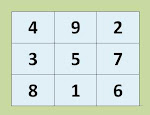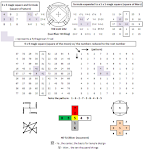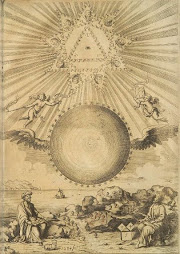HRABANUS MAURUS
The gnomon and the art of numbering is what links Heaven and earth. Secondly, magic squares were considered to be divine arrangements of numbers that could be used in magic, prognostication, and divination.
Examples of incorporating calendrical numerology and magic squares into the Christian ideology are demonstrated by the works of Hrabanus Maurus (780 – 856 AD), the archbishop of Mainz, Germany. Hrabanus was a Frankish Benedictine monk during the Carolingian period known primarily for De Laudibus Sanctae Crucis (In Praise of the Holy Cross), a masterful collection of 28 poems that feature his unusual and enduring style of poetry that incorporated imagery onto the manuscript. The letters that are enclosed within the image(s) form an additional miniature poem, that is, poems with in a poem.
Hrabanus adhered to the Church’s formula for sacred geometry as his imagery incorporates:
- A cross – in – square pattern
- The four quadrants
- An axis mundi
- Numerology associated with the four seasons, lunar or solar cycles
This formula for sacred geometry generates the quincunx, a geometric symbol that is used to identify the most sacred of objects, most commonly, illuminated manuscripts.
Poem 9 from De Laudibus Sanctae Crucis
Poem number 9 from De Laudibus Sanctae Crucis is composed of 41 lines and columns of letters. These numbers, 9 and 41, correspond to the 9x9 magic square (in the Luo Shu format) that has 41 as its center. This is only noteworthy because the 9x9 magic square corresponds to the Moon in alchemy and magic.
Therefore, it may be possible for an illiterate person to somewhat understand the message of the poem through the (numerical) imagery and the association of the numerology with the Moon and the four seasons.
Poem number nine mentions time, the revolution of the sun and the moon around earth, order and prosperity, the crucifixion; but mostly the poem is about the glorification of the cross.
What is noteworthy in the prose is the role of the light of the sun and moon upon the cross and the resultant shadow of information. Hrabanus is describing the tradition of the gnomon.
The poem can be read by substituting the gnomon for the cross.
Example: Lines 1 – 9:
1. Sun and moon, praise god Jesus Christ.
2 . The cross (gnomon) is your honor, enduring light, peace-bringing order,
3 . glory, goodness, succession, and light for all ages.
4 . Within this space of time (i.e. 365 days) you (the gnomons) measure night and day
5 . And ply your (the gnomons) course according to its perfect rhythm.
6 . The four branches of the stem (the gnomon) contain in its
7 . Thickness six times ten, five times one, and ten times thirty.
8 . For indeed it is recognized that this is the way the sun and the moon are restricted in their circular motion;
9. and the whole year goes around once through all the seasons;
And lines :
20. Altar and scepter of the high god,
20. Altar and scepter of the high god,
21. you (the gnomons) link in a strict order the underworld and the lofty sky;
22. for the cross (gnomon) is the glory of the world.
The most intriguing feature of the poem is the imagery of four hexagonal shaped figures that are inclusive of some of the letters. It has been determined that the number of letters included in three of the hexagons numbers 91, while the fourth numbers 92 for a total of 365. Therefore, Hrabanus has managed to incorporate the following calendrical numerations:
The lunar cycle of 28 days
The solar cycle of 365 days
The four seasons
The number of days in each season, 91
The number of weeks in a year, 52
The four parts of a day
John North in his The Ambassadors Depart (2002, p. 284 – 287) comments:
Some of the doctrines developed by Rabanus here help to explain an even more remarkable exercise in mysticism for which he is responsible. Praise of the Holy Cross (De Laudibus Sanctae Crucis) combines theology with mystical mathematical symbolism. While in outward form it is a literary work, it has a strong figurative element…….The verses made up from the letters inside the hexagons refer to 365 as the “universe of time”, the 3 times 91, and 91 plus one. Just how intricate the scheme is only becomes obvious when we count the numbers of letters inside the hexagons, for they represent those same numbers, the days in a season……
Hrabanus incorporates the same Chinese/Platonic/Pythagorean principles that we have seen before: the quincunx, the use of magic squares that correspond to a planetary sphere, calendar numerology, the gnomon, the solar and lunar cycle, prosperity and agriculture. All of these themes are referred to in this forty one line poem.
Furthermore, it was stated earlier that De Laudibus Sanctae Crucis was a collection of 28 poems. The number 28 corresponds to the lunar cycle because:
- The synodic revolution of the moon, that is, from new to new or full to full is 29.53 days, and
- The sidereal revolution of the moon, that is, the time it takes the moon to return to its same place among the stars is 27.33 days.
These periods are always out of step but the average of 28 served convenience.
And numerologists would take delight in the peculiarities of the number 28, that is:
And numerologists would take delight in the peculiarities of the number 28, that is:
The sum of all its divisors, 1 + 2 + 4 + 7 + 14 = 28
The sum of the first seven numbers, 1 + 2 + 3 + 4 + 5 + 6 + 7 = 28
Magic squares were obviously a great influence on the monks throughout Europe during the Carolingian age. The Coptic Gospels from Fayum, Egypt (c. 800 AD), the works of Hrabanus Maurus (810 AD), and the upper cover of the Lindau Gospels (c. 875 AD) represent the primary evidence of the use of magic squares in Christianity during this period.


















